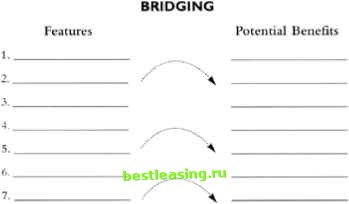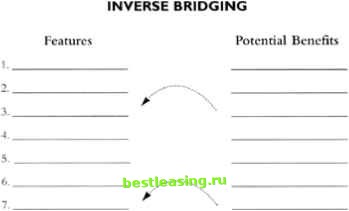

 |
 |

|
Промышленный лизинг
Методички
previous I next Effective Bridging Once you have identified the appropriate features and the hot-buttons, its time to bridge. Bridging occurs when you link the feature to the benefit. Each feature offers several potential benefits that must be explained in detail for the customer to fully appreciate it as a benefit. In the end, the customer decides if the feature is in fact a benefit. Remember, customers buy benefits, not features. Features on their own represent the so-what information I spoke of earlier. Dont feature dump. Although this book is not about scripts and rigid steps to follow, I do suggest you consider this very short, succinct script while you get comfortable with bridging, The benefit to you is ... These five words verbally initiate the bridge, taking a feature to a benefit. Once the feature is bridged to a benefit, confirm its acceptance by asking, Do you see this (feature) as a benefit to you and your business? If your customer agrees, you have successfully bridged the feature and anchored it as a benefit. The following diagram illustrates bridging. BRIDGING  The above illustration represents the three steps of effective bridging. Step 1: Step 2: Step 3: In conversation with your customer, features #2, #5 and #7 were identified as hot-buttons, relevant features. The other features proved to be of little interest, so-what information. Continue to verbally scroll your menu until you have identified three or four features of interest. Bridge appropriate features using the statement, The benefit to you is ... This statement ensures your customer is thinking in terms of benefits. Go on to explain the benefits of the feature in terms of your customers specific requirements and how the benefits relate to his or her needs. Validate the customers acceptance of the benefits by asking, Do you see this (feature) as a benefit? If yes, you have benefits. Bridging is a fundamental ingredient of a successful call. When followed, the three steps eliminate the monotony of feature dumping, identify a tailored solution, shorten the sales cycle and show customers how you can help their business. Benefits sell, features tell.  ЦШ И1:11 Inverse Bridging previous I next Inverse bridging occurs when you start with a benefit and bridge it back to the supporting feature. This approach says to the customer, This is what we can do for you (benefit) and this is how we do it (feature). This is an excellent strategy to make a telephone appointment, to create demand in a new or existing account, or to gain interest when making cold calls. Customers frequently challenge salespeople by demanding, Why should I see you? or How can you help my business? or Im too busy, call me in three months. Sound familiar? When on the telephone the challenge is to get the customers attention quickly and sell the appointment. Features rarely get attention quickly, but by stating a benefit right up front you may bait the prospect enough to stimulate mild curiosity. The question is, what benefits do you use to stimulate interest? My advice is to use the benefits that have proven popular with current customers. Do some research. Know the benefits of your product or service that are consistently accepted by your customer base. Alternatively, offer a benefit that you know will directly impact your customers business. Remember, it is the customer who validates your benefit so dont be shocked if they reject your initial attempt at inverse bridging. If they do, simply acknowledge their indifference and suggest other benefits that may be more relevant. The objective with inverse bridging is not to sell them, but to gain access. The following illustration shows inverse bridging. INVERSE BRIDGING  Every salesperson at some point in time has experienced the frustration of trying to make appointments. One approach that has proven effective is to suggest to the potential customer during the initial telephone conversation that you may not have anything to sell him or her. If they ask, What are you going to sell me? simply respond with, At this point, Im not sure-maybe nothing. However, what I would like is 15 minutes of your time to explore the possibility of our companies doing business. The very suggestion that you are not trying to sell them something will get the customers attention. They will feel more relaxed about granting you an appointment. The use of inverse bridging and the maybe nothing statement is a potent combination that will increase your success with first-time appointments. Participants at my seminars agree that this approach is unconventional but they recognize how it can be immensely effective. jmj Hl8l 
1 2 3 4 5 6 7 8 9 10 11 12 13 14 15 16 17 18 19 20 21 22 23 24 25 26 27 28 29 30 31 32 33 34 35 36 37 [ 38 ] 39 40 41 42 43 44 45 46 47 48 49 50 51 52 53 54 55 56 57 58 59 60 61 62 63 64 65 66 67 68 69 70 71 |